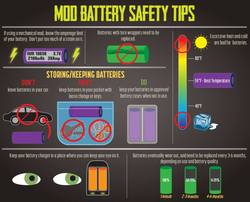 I’m not an expert on lithium-ion batteries, but I’m starting to notice a trend. Whether we’re talking about laptops, cellphones, hoverboards, e-cigarettes or other devices, when fires and explosions take place, it seems that it’s usually not the device itself, but the battery that is the cause. Click on the image for a useful infographic on battery safety.
I’m not an expert on lithium-ion batteries, but I’m starting to notice a trend. Whether we’re talking about laptops, cellphones, hoverboards, e-cigarettes or other devices, when fires and explosions take place, it seems that it’s usually not the device itself, but the battery that is the cause. Click on the image for a useful infographic on battery safety.
There are several reasons why lithium-ion batteries can catch fire or explode. Lithium-ion batteries are made to deliver a high output with minimal weight. Battery components are designed to be lightweight, which translates into thin partitions between cells and a thin outer covering. The partitions or coating are fairly fragile, so they can be punctured. If the battery is damaged, a short occurs. This spark can ignite the highly reactive lithium.
Another possibility is that the battery can heat to the point of thermal runaway. Here, the heat of the contents exerts pressure on the battery, potentially producing an explosion.
Regardless of the cause, and regardless of the device involved, fires and explosions involving lithium-ion batteries can be deadly.
On September 3, 2010, a UPS 747 crashed near Dubai, killing the two crew members. A subsequent investigation indicated that the crash resulted from a fire the overwhelmed the plane’s fire suppression system. The report indicated that the fire was caused by the autoignition of the contents of a cargo pallet, which contained “a significant number” of lithium type batteries and “other combustible materials”. In October 2010, the FAA issued a Safety Alert for Operators highlighting the fact that the cargo on board Flight 6 contained a large quantity of lithium type batteries. The FAA issued a restriction on the carrying of lithium batteries in bulk on passenger flights.
Lithium-ion batteries are also used to power hoverboards, the controversial self-propelled platforms that sparked more than 52 fires over Christmas, causing $2 million damage. While the US Consumer Product Safety Commission is now working nonstop to figure out the actual root causes of these incidents, they don’t have the answers yet. “We want to be able to deliver for the public, but we hope they’ll be able to appreciate that what’s going on right now is a very thorough science-based investigation,” said CPSC spokesman Scott Wolfson. In February, 2016, the organization officially warned that hoverboards pose a serious risk, and threatened to block imports or recall hoverboards that don’t meet voluntary safety standards. However, it is important to note that it is not the hoverboards themselves, but the lithium ion batteries in them, that are the most likely cause of the fires.
Fires like these aren’t exactly new. We’ve been living with potentially deadly explosions in our pockets and laptop bags for years. In 2004, there was a spike in the number of cell phone battery explosions, and Dell recalled millions of laptop batteries in 2006 after just six incidents of fire. More recently, Boeing had to ground the 787 Dreamliner airplane until it could find a way to keep its lithium ion batteries from overheating.
Earlier this month, the lithium ion battery in a toddler’s light-up shoes ignited, causing a fire in the family’s SUV. Payless, the retailer that sold the shoes, has issued a recall and launched an investigation.
Also in the news recently have been several incidents involving vaporizing devices, a relatively new technology that has helped many people quit smoking cigarettes. While the news coverage tends to imply that the vaporizing devices, or e-cigarettes themselves are to blame, the most likely source of these relatively rare incidents is the lithium ion batteries that power the devices.
Recently, researchers at Stanford University have developed lithium-ion batteries that do not catch fire. These new batteries are designed to shut down before overheating and then restart immediately once the temperature cools down. Again, I’m not an expert on batteries, but if this new technology can help avoid unnecessary injuries, I believe it should be adopted for use in consumer products as quickly as possible.
We at the Law Offices of Matthew D. Dubin are deeply committed to the rights of the injured. Any time a person is injured or killed as the result of a fire or explosion associated with a lithium ion battery, or by any battery in any device, whether it’s a laptop computer, a cellphone, a hoverboard, an e-cigarette, or a pair of children’s shoes, the victim or his family should immediately consult with a qualified personal injury attorney. If the incident is determined to be entirely the user’s fault, there may not be a legal claim to pursue. However, the real cause usually has to be determined by experts, not the victims or their lawyers. If the fire or explosion is determined to be the result of negligent design or manufacture, the injured person may be entitled to compensation for his or her injuries.
